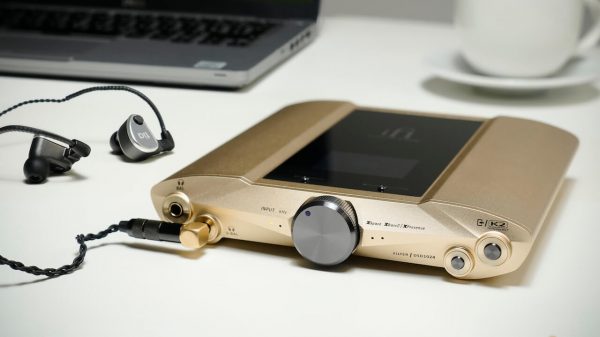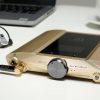When Ricardo contacted me by email to check if I wanted to try any of the products he represented, I thought he was making the mistake of believing that I was physically located in Latin America. I explained that Amigos HiFi was based in Barcelona and that it separated us by a significant distance; not to mention completely different power requirements. Reviewing the iFi NEO iDSD DAC might not be possible.
That’s when he clarified to me that he was the global representative for iFi Audio for the Spanish-speaking market. Let’s get to it. Two components were requested and within a few days they were made available to the publication. The Neo iDSD (DAC + preamp + headphone amplifier) and ZEN Phono (phono preamp) were sent to myself and Manel Segarra who has had the phono preamp for a few days and will soon share his observations.

The natural location for this DAC should be considered something like SoHo (Small Office Home Office). It takes up very little space in an environment where space is at a premium. It can be placed both horizontally or vertically and can be integrated in a manner that it becomes the hub for either a Mac or PC. In addition, it is aesthetically pleasing and you will not want to hide it away on the floor on inside a bookshelf. iFi clearly understands that users will want easy access to it and have made such a device.
Another very important issue for audiophiles putting together a high-res desktop system is knowing the format and bit/sampling rate of the digital music that they are listening to. Audiophiles are neurotic creatures. They need to know the most mundane things that the average consumer doesn’t care about. In a world that has become digital; where consumers have access to a dozen major streaming services, having a DAC that interprets everything provides a degree of transparency. Other brands like Topping that have become very popular with the Head-Fi and desktop audio crowd, offer similar products for under $200 that display format, bit/sampling rate, volume level, and other system details. iFi have no choice but to offer this type of feature with their products.
Let’s be honest — the majority of people who acquire a DAC for their office, have some interest in better sound quality and want a higher level of functionality. The iFi NEO iDSD offers the ability to listen to various streaming platforms in high-res and can also also be used as a preamp with an external amplifier or active loudspeakers. The 3 digital inputs increase its value because it can be connected to multiple digital devices at the same time; including those who might use a Roku box with a television or computer monitor with HDMI input in their office. Most of the video streaming devices use a S/PDIF optical output so just run a cable from the streamer to the rear panel of the NEO iDSD and you can listen to your favourite shows or movies with much better sound quality.

The input source select and power buttons are on the small side and while the panel is quite useable, I do wish they were larger for those with thicker fingers.
From a technical perspective, iFi have packed a lot of technology inside this chassis and support for formats like DSD and MQA make it somewhat future-proof; at least in the short-term for audiophiles who may connect an external server loaded with DSD files or who use Tidal.
What’s inside the box?
The NEO iDSD DAC comes with an external transformer with interchangeable plugs for the different electrical sockets depending on the market. iFi does this with almost all of its products which is a godsend for customers. I do wish that more manufacturers did the same thing. The power transformer is self-regulating and supports all of the different electrical voltages that one may find in Europe, Asia, South America, and N. America. A removable antenna for Bluetooth 5.0 is supplied, along with USB and RCA cables. Unfortunately, the length is quite short and may be insufficient in a situation where you have to connect to a computer far from the table, for example. It has the exact length to be connected to a laptop. iFi have also included a base so that users can place the DAC vertically, and some silicone tears in case you want to place it horizontally. A credit card-type remote control, DIN-to-mini-DIN headphone jack adapter, and a well-written user manual are also included.
You can’t put that on my desk
As much as I wanted to connect the the NEO iDSD to my Pass Labs INT-250, it wasn’t very practical to put that on my desk (the amplifier weighs over 100 pounds), and it wasn’t the ideal way to test it. Very few people buying the iFi DAC are likely to use it with equipment or loudspeakers that are 20 times the asking price but I wanted to gauge its performance at the highest levels. To give potential users a better sense of its capabilities, I tried it in multiple scenarios.
Home alone
The most logical and common place to use the NEO iDSD would be on the desktop connected to a computer through its USB port. In my case, and I’m on the wild side of life, the system is a Linux Ubuntu 20.10 Desktop; which proved to be a plug and play scenario with zero compatibility issues. No problem in the recognition and lock of the signal. When I started listening to music, the signal started immediately.
The OLED screen offers a clear reading of the information according to the format, and bit/sample rate. The brightness is not distracting at all. The volume dial is the right diameter for a front panel of this size and I found it very easy to use. iFi have made a few blunders with some of the switches and buttons on some of their devices which can be hard to read (the bottom panel of the iPhono3 Black Label phono preamp), but the NEO iDSD has zero issues in that regard.
I decided to use two headphones during the review; the AKG K-701 open-back headphones which are quite demanding, and a very basic Sony model that is very common here in Spain and often sold in supermarkets.

With the AKGs, one of the first things that you notice is that the volume control can “only” work in the upper part of the range because at -80 dB, it is inaudible. At minus -60 dB, we had adequate volume to avoid silence but I could hear everything going on around me in the room. I had to listen at -30 dB for adequate volume levels and dedicated listening sessions.
Sonically, the NEO iDSD was very clean and open sounding; in the case of the AKG headphones, it was too much of a good thing. At least for me. The AKG is already a very neutral sounding headphone and the DAC/preamp proved to be too much of a good thing.
I would recommend closed-back headphones with the iFi and those with a darker tonal balance and more laid-back presentation. The Meze Audio Classic 99s would be a strong option in this category.
When I connected the Sony headphones, the amount of gain made it easy to listen to these headphones using less power, and I was stunned by how much better they sounded. Usually, I have them with my Huawei mobile and the sound was not even close to what I achieved with the NEO iDSD; greater clarity and transparency, improved detail retrieval, and far more midrange and bass resolution.
Home alone (again…just without Joe Pesci)
Switching to Bluetooth created a scenario where it was very easy to pair my mobile device to the NEO iDSD (a female voice notifies you of the successful connection), but also forced me to turn the volume up even higher with the AKG headphones to achieve a meaningful volume level in order to discern finer layers of detail. I also found the treble slightly harder sounding when streaming from a mobile device; almost everything had a slight edge to it that I did not hear when using the USB input.

I do not know. It’s possibly an age thing or because of preconceived ideas, because I’m not 100% sure how I feel about this particular configuration. It has made me think harder about how music is consumed now, and whether people are really listening to music in the best possible manner when using their mobile device.
NEO iDSD on steroids
I made the decision to turn off the DAC and reset it in a different configuration. When I turned it back on, I pressed the button and the screen displayed “FIX VAR” with a line underlining VAR (variable). I then turned the knob to the left placing the underline on FIX (fixed) and pressed the knob to accept the change. We already had the variable output set to fixed. I had previously connected the RCA output to my Little Dot MK IV headphone amp. The change from variable to fixed was done to eliminate a component (the attenuator) and get a purer signal by eliminating stages of the signal path.

Making this change altered the sound quality in a significant way. The difference in power output was very noticeable almost immediately; the AKG had previously struggled with the NEO iDSD at lower levels but the decision to use just the DAC section with my external headphone amplifier created a much greater sense of depth with the headphones. Everything opened up, and the warmth of the Little Dot headphone amplifier transformed music in such a manner that the AKG sounded like different headphones. The iFi NEO iDSD was no longer the weakest link in the chain. It was now free to unravel complex musical passages and pass that signal to the superior sounding headphone amplifier when using the AKG headphones.
If you purchases the NEO iDSD, understand that this is the best way to use it.
What’s a nice girl like you doing in a place like this?
Inserting the NEO iDSD into my larger computer-based rig was a test to see how it compared to two titans. The previous DAC I had reviewed was the PS Audio DirectStream which retails in Spain for almost ten times the price of the iFi DAC. Before the American PS Audio DAC had arrived, I was very fortunate to review the Italian Gold Note DS-10 DAC which is also significantly more expensive than the iFi DAC. Listening to one of my favorite albums, Coladito de Maná (acoustic version), allowed me to hear the differences between the three DACs. The more expensive DACs had a greater sense of mass, more tonal color, and certainly a resolute low end. One would expect to hear these level of differences considering the price differential, but the iFi did not fall far behind in one significant area.

The NEO is a new product and surely its creators are neither my age and nor do they share my musical tastes. Who knows, there are surprises in life. For years, I was professional DJ in nightclubs in Spain. Following this thread, I started looking for high quality recordings, but specifically music with a lot of rhythm. Pace is a better word for it. Despacito by Luis Fonsi sounded almost insulted to me. The NEO seemed to shout at me loudly, “finally, now you find out.” And the trend continued with El Perdón by Nicky Jam and Enrique Iglesias, and Dancing by Enrique Iglesias and a few more. I ended up with La Gozadera de Gente de Zona. I didn’t need to continue. I know what sound I was looking for with these tracks and the NEO iDSD nailed it every time.
In short, the NEO IDSD is a product adapted to its time and its generation. It is small, well-built, simple to use, and with features that place it just below where the heavyweights of the category. When used as a DAC, it delivers an engaging and passionate performance with music that I care about deeply. It is also quite affordable. It is a DAC that understands me and for that I am grateful.
Learn more: ifi-audio.com/products/neo-idsd/
Where to buy: $699 at Amazon
The Spanish version of this article originally appeared at Amigos Hi-Fi.




































